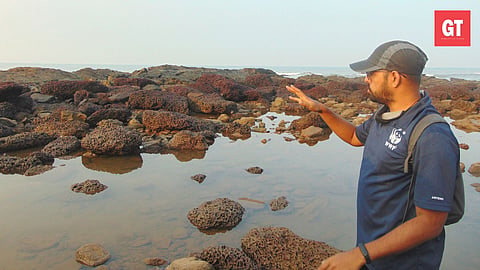

Gaurav Patil explains the finer points about Goa's marine diversity during a 'Tidepool Walk'
PIC COURTESY: Arti Das
Sunday mornings are usually a time to relax and unwind, preferably on a beach if you are in Goa. But, have you ever considered a beach, or any other shoreline, as a nature spot where you can learn about marine biodiversity? Or, have you ever wondered about those creatures that suddenly pop up under your feet, while walking on the beach?
Such is the curiosity that led me to Anjuna beach early one Sunday morning, where I discovered amazing marine life as part of the ‘Tidepool Trail: Anjuna beach,’ organised by the Goa Forest Department and WWF India. This event was part of ‘Shorelore 2022— Coastal excursions & awareness’ sessions. It aims to celebrate the rich biodiversity of Goa’s shoreline, and work on its conservation through citizen science.
Participants of a 'Tidepool Walk' explore the biodiversity of the location
PIC COURTESY: Arti Das
ROCK DWELLERS
It was an eye-opening session for all the participants as they discovered the resilient creatures of the upper inter-tidal line, found under rocks. Wondering what is a tidepool? It is a place where there is a confluence of sea and land. It is where the water gets accumulated in rock crevices or a depression, which is left behind by the retreating sea during the low tide.
So, such walks are held during low tide, when one can discover a variety of crabs, shrimps, snails, limpets, barnacles, algae, etc.
Our walk started with an explanation of the tides and the rocks, where these creatures are found, before venturing near the shore. Sadly, during our walk, we were enveloped by loud music, emanating from a nightclub near the shore that early in the morning. It was quite ironic — on one hand, we had participants from different walks of life who were curious to know about marine life, and on the other hand there were party revelers who were apparently not aware of their surroundings.
Snails stuck to the bottom of a rock
PIC COURTESY: Arti Das
SMALL, BUT FASCINATING
Our guide, Gaurav Patil, who is a marine biologist and part of WWF India, explained that on such shores, we usually find rocks like laterite, basalt and granite. He further informed that in North Goa, not many species were found on laterite. But as we move towards South Goa to places like Agonda, Talpona, there’s more diversity on laterite as well.
We then came across a fish, skittering around in the water, which is known as sand goby. Patil informed that they were related to mudskippers and one amazing aspect about them is that they have a map of the inter-tidal zone and can store a memory of up to 20 days! They are also territorial.
It was then time to discover a variety of snails, some of which, were stuck to the rocks below. We discovered Gyrineum natator, top shell (Trochus sp), Turban shell (Turbo sp), Pirenella snail, etc. and crabs like hermit crabs, maroon rock crab, rock crab juveniles, moon crab, soldier crab, etc.
We also found a snail, known as ‘tambaku’ or tobacco in Maharashtra, because it tastes like tobacco, when eaten.
After walking, and slipping on slippery rocks, we came across a pistol shrimp that kills its prey with a vacuum bubble. Patil explains, “It closes its big claw so rapidly that it creates a vacuum bubble. The bubble is usually directed towards the prey with the help of the claw, like a gun. The heat of that vacuum bubble is said to be equivalent to the sun’s surface temperature. The prey is usually a small fish or any other small animal, which dies instantly after coming in contact with the bubble.” It was unbelievable to discover this because it is such a small creature, yet, it is capable of such acts.
At the end of our walk, we discovered some green turf algae and brown algae called Padina and Sargassum.
This two-hour walk took us to the wonderful world of marine life, where we learned about the resilience of these minute creatures, which are fighting many battles to just survive.
Such walks make us realise the wealth that Goa has, especially our marine life. Sadly, there’s hardly any awareness about it. We have reduced our beach areas to picnic and party spots, but in reality, these spaces are brimming with life.
So, the next time you go to the beach, make an effort to observe these tiny creatures, and if you want to learn more about them, join the next session of ‘Shorelore 2022’, where they focus on our mangroves, coastal birds, tidepools and other coastal flora and fauna.
UPCOMING EVENTS
WHAT: Sea Turtle Beach Walk
WHERE: Morjim
WHEN: March 6, 2022
TIMINGS: 3.30 pm to 5.30 pm
TO REGISTER: https://docs.google.com/forms/d/1dSktS2b-4amH1cMc2Cg9WKFOo0nv9FseFqhlyfi1yKc/viewform?ts=621f339a&edit_requested=true
WHAT: Tidepool Walk
WHERE: Anjuna
WHEN: March 20, 2022
TIMINGS: 7 am
OTHER INFO ABOUT THE ABOVE WALKS
ENTRY FEE: Nil
CONTACT: +91 8999670133